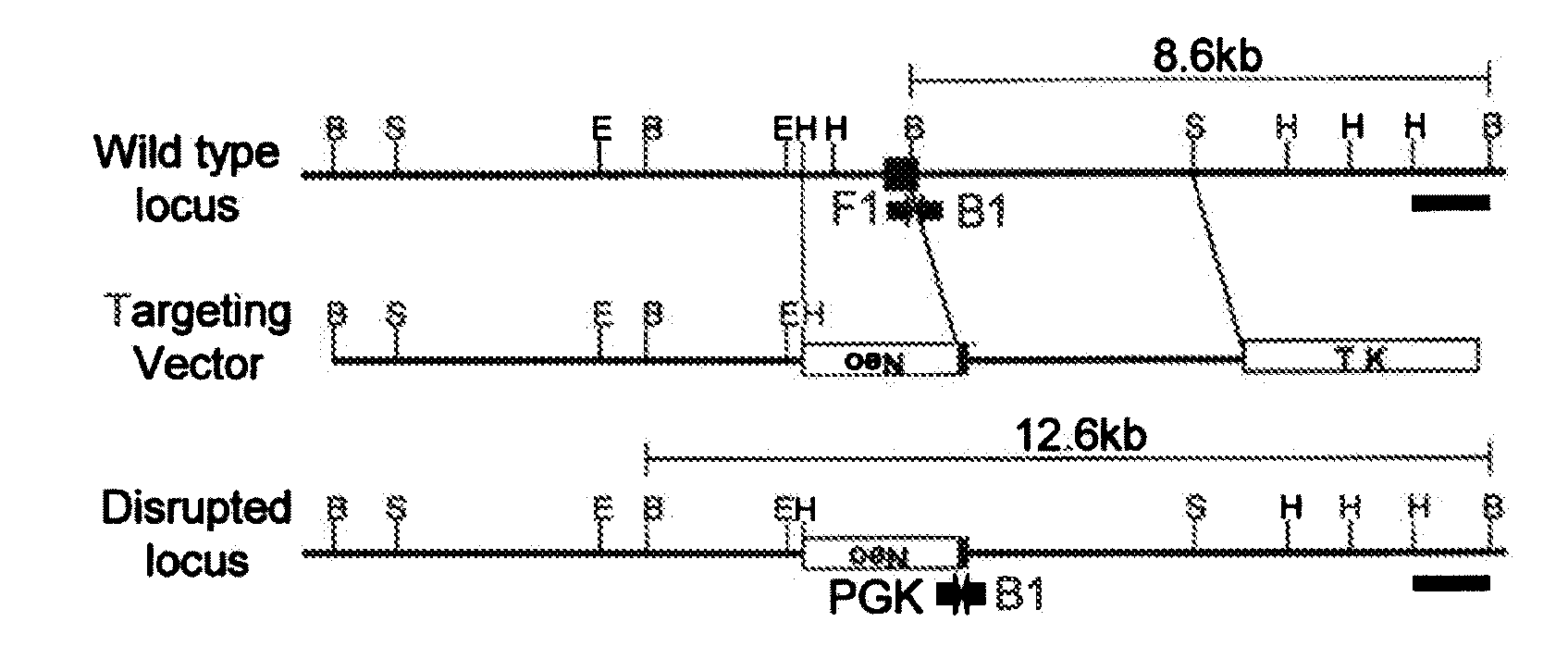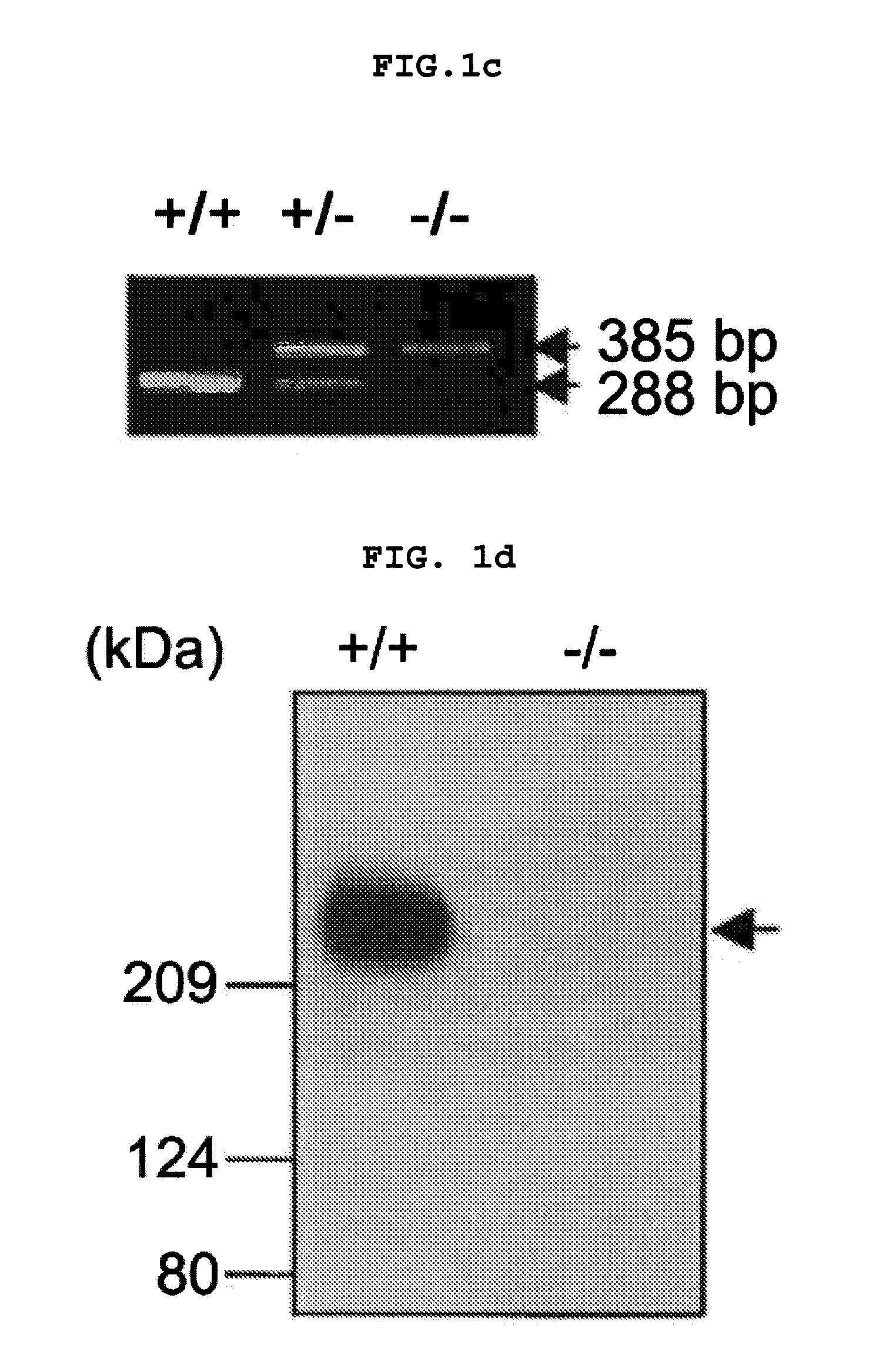Transgenic mouse whose genome comprises a homozygous disruption of its alpha1G gene, a method of preparing the same and use thereof
a technology of transgenic mouse and homozygous disruption, applied in the field of transgenic mouse, can solve the problems of difficult and limited treatment of epilepsy, difficult blood vessel or organ treatment, and inability to fully respond to epilepsy, so as to suppress the function of 1g protein and resist epilepsy.
- Summary
- Abstract
- Description
- Claims
- Application Information
AI Technical Summary
Benefits of technology
Problems solved by technology
Method used
Image
Examples
example 1
Generation of Targeting Vector and Transfection
Generation of Targeting Vector
[0089]To generate a knockout mouse for the α1G subunit of T-type calcium channel, the present inventors carried out a gene targeting method.
[0090]Particularly, a mouse cDNA of the α1G gene (cacnalG) sequence corresponding to 688-1008 bp of the rat cDNA was isolated by RT-PCR. Using the above isolated sequence as a probe, a bacteriophage lambda FIX II library (Stratagene) wherein DNA fragments of 129 / sv mouse genome were inserted randomly was screened. From this, the genomic phage clone containing α1G gene was selected and confirmed by restriction mapping, Southern blotting, and sequencing.
[0091]The targeting vector was designed to delete most of the exon encoding amino acid residues 82-118 that comprise the N-terminus of the α1G protein. To enhance targeting efficiency, a thymidine kinase gene cassette and a negative selection marker were inserted into the 3′ of the targeting vector (FIG. 1A).
Culture of E...
example 2
Generation of Chimera Mice
[0096]To generate chimera mice having α1G + / − genotype, embryonic stem cell clone selected in Example was microinjected into fertilized blastula. Particularly, female and male C57BL / 6J mice (obtained from the Jackson Laboratory of Bar Harbor, Me.) were mated, and three and a half days after mating, the female mouse was sacrificed by cervical dislocation. Uterus was removed from the sacrificed female mouse and the terminal region of the uterus was cut with scissors. Using a 1 Ml syringe, 1 Ml of injection solution containing 20 mM HEPES, 10% FBS, 0.1 mM 2-mercaptoethanol, and DMEM was circulated. Blastula was separated from the uterus using microglasstube under the dissecting microscopy. The separated blastula was transferred to a drop of injection solution and placed on a 35 mm petri dish. Ten to fifteen embryonic stem cell clones were inserted into blastocoel of the blastula by using a micro-injector (manufactured by Zeiss of Germany). The above blastula ...
example 3
Generation of α1G + / − Heterozygote Mice
[0097]Among offspring generated from mating a C57BL / 6J female mouse with a male chimera mouse obtained in Example 2, genetically stable heterozygote F1 transgenic mice were selected. PCR was performed to select heterozygote mice having α1G + / − genotype among them. DNA for PCR was extracted from the tails of the mice. Particularly, 1.5 cm of mice tail was cut and dipped in 0.4 ml of lysis buffer containing 100 mM Tris-HCl (pH 8.0), 5 mM EDTA, 200 mM NaCl, and 0.2% SDS. Proteinase K (0.1 mg / ml) was added to the above solution and reacted at 55° C. for five hours. Thereafter, 75 μl of 8 M potassium acetate and 0.4 ml chloroform was added and the resultant was agitated. The solution was suspended at 4° C. for ten minutes. Supernatant and sediment were separated by centrifugation at 15,000 rpm. One milliliter of ethanol was added to the 0.4 ml of separated supernatant to precipitate genomic DNA. The precipitated genomic DNA was washed with 70% ethan...
PUM
| Property | Measurement | Unit |
|---|---|---|
| Magnetic field | aaaaa | aaaaa |
| Electrical resistance | aaaaa | aaaaa |
| Strain point | aaaaa | aaaaa |
Abstract
Description
Claims
Application Information
 Login to View More
Login to View More - R&D
- Intellectual Property
- Life Sciences
- Materials
- Tech Scout
- Unparalleled Data Quality
- Higher Quality Content
- 60% Fewer Hallucinations
Browse by: Latest US Patents, China's latest patents, Technical Efficacy Thesaurus, Application Domain, Technology Topic, Popular Technical Reports.
© 2025 PatSnap. All rights reserved.Legal|Privacy policy|Modern Slavery Act Transparency Statement|Sitemap|About US| Contact US: help@patsnap.com



